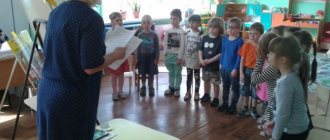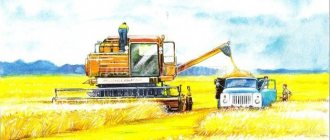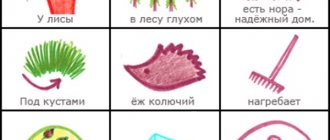The author of the article is methodologist Natalya Aleksandrovna Loginova. The article is the final one in a series of lectures devoted to the development of speech in older preschoolers.
Why do you think some children who have difficulty memorizing poems and rules remember the plots of movies and cartoons so easily and quickly? Have you noticed that after explaining the lesson material, some children remember what was discussed, while others forgot? And they listened, in general, carefully! And how to find something similar to a hook that can hook knowledge and keep it in the child’s memory? What can hold attention and make the memorization process simple and effortless? Story pictures come to the rescue.
What is mnemonics?
If the child is silent, show him the picture and he will speak. Ushinsky K.D.
Mnemonics translated from Greek is the art of memorization, the technology of memory development. This is a system of methods and techniques that ensures successful and effective memorization of information. Idea: for each word or phrase, a picture is invented and the entire text is sketched. Any story, fairy tale, proverb, poem can be “written down” using pictures or symbolic signs. Looking at these diagrams, the child reproduces the information received.
The diagrams serve as a visual plan to help the child recreate what he heard. Speech therapists use such support diagram cards very effectively. Mnemonics and kinesiology (the science of brain development through certain hand movements) were used by Aristotle and Hippocrates.
Teachers and parents who work with children can also use the mnemonic method when teaching retelling and composing stories, when asking riddles, and when learning proverbs, sayings and poems by heart.
K.D. Ushinsky wrote: “Teach a child some five words unknown to him - he will suffer for a long time and in vain, but connect twenty such words with pictures, and he will learn them on the fly.”
The method of mnemonic tables helps to effectively perceive and reproduce the information received.
As practice has shown, this technique makes it much easier for children to find and memorize words, sentences and texts.
Mnemotables:
- are didactic material for speech development;
- they can be used to replenish vocabulary and develop speech;
- use when teaching retelling and composing stories, memorizing;
Using mnemonic tables you can solve problems such as:
- Speech development and vocabulary replenishment.
- Converting images into symbols.
- Development of memory, attention and creative thinking.
- Development of fine motor skills.
Using mnemonic tables in kindergarten
Often teachers use ready-made schemes by T.A. Tkachenko and sensory-graphic schemes by V.K. Vorobyova, which they take as a basis, make their own changes and successfully use for classes in kindergarten. The mnemonic technique is a simple technique for speech development that facilitates memorization and is implemented through the use of mnemonic tables and graphic drawings. A mnemonic table is a diagram that contains certain information. Working with such tables is based on the principle “from simple to complex.”
It’s very easy to make mnemonic tables yourself for kindergarten classes on any topic.
For example, for the speech game “Like Grandma Natasha” you can use the following mnemonic table for memorization:
Like Grandma Natasha (hold the ends of an imaginary scarf placed on your head, speak with a lisp, like an old woman)
We ate delicious porridge (put your palms together in front of you - make a “plate”, show it to everyone standing on the right and left).
Millet porridge with smoke (over the open palm of the left hand there is a “plate”, with the index finger of the right hand draw an imaginary smoke coming from the hot porridge, the smoke rises upward, so the text is chanted),
Millet porridge with smoke (repeat the same movements, but the right hand is “plate”, the left is “smoke”),
With bread (right hand in front of the chest, elbow to the side, the inner side of the palm looking down - “a loaf of bread”),
With oil (cover your right palm with your left palm - “layer of oil”),
With milk (join the wrists, fingertips and thumbs raised up - “mug”).
We took large spoons (clench your fists, thumbs up, spread to the sides - two “spoons”),
We ate everything down to the crumbs (alternately using the right and left “spoon” to eat the “porridge”, bringing the “spoons” to the mouth)!
This is such a mess (make a “plate” again and show it to everyone standing to the right and left)
At Grandma Natasha's (again, grab the ends of an imaginary handkerchief, speak like an old woman)! (Folk words)
You can make a syncwine:
Millet porridge, smoky We cooked it, ate it, ate it all, ate everything down to the very crumbs! Tasty food!
Thus, you can create memorization schemes for poems and stories, proverbs and sayings. For example: If you chase two hares, you won’t catch either.
It is very convenient to use the method of mnemonic tables when compiling descriptive stories.
For example: a story about yourself.
- My name is_____________. Mom's name____________. Dad_______________.
- I have a younger (older) brother (sister)___________________________.
- Mom works______________, and dad_________________________________.
- My grandmother_____________________ knows how to knit and sew, and my grandfather______ likes to garden and make things out of wood.
- My brother (sister) and I love to relax at our grandparents' dacha. There we play ball, swim in the river, go to the forest.
- We love our family very much.
When composing a story, the child can draw pictures himself.
You can make a plan for retelling the text “Favorite Fruit”
Pears are fruits. They grow on trees called pear trees. They come in green and yellow. Growing in the garden. My pear is yellow, large, sweet and juicy. You can make compote and jam from pears. Pears are very healthy. They contain a lot of vitamins.
Mnemonics in practice. From personal experience
How to shape a child’s speech and help him feel the rhythm of speech, fill his speech with beautiful and correct words, teach him to compose phrases and sentences? Use mnemonics.
In my classes with children, I used an excellent book, a collection of stories for the development of speech by Belousova L.E. “Learn to retell? It's simple!". Well-chosen poems and stories with symbolic pictures greatly helped the children in retelling. For each story, there are picture prompts that help the child remember and retell the texts. The pictures in the book can be colored. This helps develop fine motor skills.
Using symbolic pictures in the lesson, I saw that at first the children were afraid to retell, because it seemed to them that they did not remember anything and could not express their thoughts. But gradually they realized that telling stories from pictures is interesting, amusing and not at all difficult. Gradually it turned into a feasible game. They even asked us to “play with the pictures” during every lesson! After all, you don’t need to memorize anything, you just need to playfully “read the pictures.” Children play, and we see meaningful memorization as a result.
Schemes and symbol tables are assistants that help to perceive auditory information, process visual information and, without fear of making mistakes, reproduce it.
At first, the children and I retold using pictures from a book, then they themselves learned to diagrammatically depict the text for retelling.
As a result of working with mnemonic tables and pictures, the children learned to come up with symbolic pictures themselves and could easily retell any text.
Progress of the lesson.
Greetings. Children enter to the music.
Q: Guys, how does this music make you feel? What kind of music is this?
D.: calm, sad, sad.
Q: What time of year is it now?
D.: autumn .
V.: Today we will talk about autumn . Guys, what words can you use to start a story about autumn ?
D.: autumn , autumn .
V.: I suggest you tell us what you know about autumn using a table .
Children's storytelling using the mnemonic table " Autumn "
.
V.: oh, guys, I hear something, it seems like someone is crying?
A toy bunny with a carrot appears.
Bunny: Hello, guys!
D.: Hello, bunny! We are very glad to see you visiting us.
V.: Let's pet the bunny. We are not afraid of him, and he is not afraid of us either.
Why are you crying, bunny?
Bunny: I’m crying because a wolf was chasing me. I was picking vegetables in my garden, and the wolf probably wanted to take my carrots away. What should I take to my bunnies?
V.: Don't cry, bunny. Let's guys sit on the chairs and calm the bunny down. What should we call him affectionately?
D.: bunny, bunny, bunny….
Bunny: thank you guys, you are so kind.
V.: Guys, let’s tell you what we know about the bunny.
Children's storytelling using the mnemonic table “Hare”
Bunny: Well done! I really love grass, cabbage, carrots, and the wolf wanted to take away my carrots and all the vegetables.
V.: Don't cry, bunny. Now the guys will tell you everything about the wolf .
Children's storytelling using the mnemonic table “Wolf”
Bunny: thanks guys, that means he didn’t need the carrot, he wanted to eat me. Now I also know everything about the wolf and can outsmart him. Let's play our bunny game "Wolf and Hares"
They turned into bunnies.
The bunny puts on a wolf mask, and the guys turn into bunnies.
Bunny: Spin around, spin around -
And they turned into kids.
The children take their seats.
Bunny: it’s cold outside, I don’t like autumn . Do you guys like autumn ?
D.: It can be cold in the fall , it rains, there are puddles in the yard.
V.: but our guys won’t go into puddles.
V.: Bunny, how do you understand the expression “A smart person won’t go into a puddle, a smart person will avoid a puddle”
?
Bunny: I'm smart, I run through puddles - it's so cool! Try it guys!
V.: What are you, bunny, you can’t run through puddles.
Bunny: why? Here I am running. Tell me why you can’t run through puddles?
D.: You can get your feet wet and get sick.
V.: That’s why you can’t go running through puddles.
Bunny: yes, now I will also avoid puddles. Who likes autumn and why ? Children's answers.
Bunny: now I know that in autumn there is something good and something bad.
V.: Now, guys, let’s put our hands on our knees and try to remember what we did today.
D.: listened carefully to the music, came up with affectionate words for the bunny. Based on the pictures, we made up stories about a hare , a wolf, and came up with a story about autumn . Together we played the game “Wolf and Hares”
.
V.: You had a wonderful rest, and now the lesson is over. Bunny has a treat for you!
Musical lounge “Autumn Sadness” Musical lounge “Autumn Sadness” Purpose: Through classical music, help to see the beauty of nature. Objectives: 1. Improve musical skills.
Song Autumn is a sad time! for older children. Autumn is the time of year when significant changes occur in nature. She is bright, unpredictable, generous. It causes something different for each of us.
Source
What does mnemonics give?
As a result of using schema tables and mnemonic tables:
- Not only vocabulary expands, but also knowledge about the world around us.
- There is a desire to retell it - the child understands that it is not at all difficult.
- Memorizing poetry turns into a game that children really like.
- This is one of the effective ways to develop speech in preschoolers.
It must be remembered that the level of speech development is determined by the child’s vocabulary. And just a few steps taken in this direction will help you develop your preschooler’s speech.
Compiling the story “Autumn” using a mnemonic table (middle group – from 4 to 5 years old)
Sveta Sirotkina
Compiling the story “Autumn” using a mnemonic table (middle group – from 4 to 5 years old)
Topic: “ Composing the story “ Autumn ”
according to
the mnemonic table "
( middle group – from 4 to 5 years )
Goal: to consolidate children’s ideas about the characteristic signs of autumn and autumn phenomena .
1. Exercise children in the ability to talk about the seasons ( autumn )
using visual aids (
mnemonic squares , mnemonic table , coherently, in a logical sequence.
2. Develop vocabulary - name the distinctive features of autumn , wild animals, birds using a mnemonic table .
3. Strengthen the skill of forming an adjective from a noun.
4. Continue to develop mental processes: memory, attention, visual and effective thinking.
5. Develop the ability to correlate drawn symbols with an image.
6. Cultivate a kind attitude towards nature, show care for it.
Material: Demonstration: mnemonic squares , mnemonic table “ Autumn ”
,basket, pointer, ball, phonogram with music
“Dance with
Autumn Leaves ” , music by P. I. Tchaikovsky
“October”
.
Handout: 2 autumn
Previous work: observing autumn changes in nature, looking at illustrations , conversations, memorizing poems about autumn , getting acquainted with symbols - drawings of mnemonic squares , learning visual and finger gymnastics, singing songs about autumn .
Integration of educational areas: “Communication”
,
“Cognition”
,
“Health”
,
“Music”
,
“Reading art.
literature" .
Change of positions: org. moment - standing in a circle on the carpet;
Part 1 - sitting at desks
musical-dynamic pause - in a circle on the carpet;
Part 2 - at the desks
the result is on the mat in a free position.






